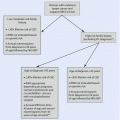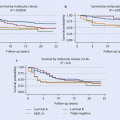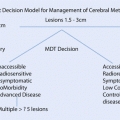Khorana score for short-term risk of VTE
Points
Type of cancer
Stomach, pancreas
Lung, lymphoma, gynaecologic, bladder, testis
Others
2
1
0
Platelet count
<350 × 109/l
≥350 × 109/l
0
1
Haemoglobin
≥10 g/dl and no therapy with erythrocyte-stimulating factors
<10 g/dl or therapy with erythrocyte-stimulating factors
0
1
White blood cell count
≤11 × 106/l
>11 × 106/l
0
1
BMI
<35 kg/m2
≥35 kg/m2
0
1
Total score
Low risk (<1%)
Medium risk (2%)
High risk (7%)
0
1–2
3–6
Wells score for PE or VTE points
Active cancer
Surgery or bedridden for ≥3 days during the past 4 weeks
History of PE, or DVT
Haemoptysis
Tachycardia, HR >100/min
Clinical suspicion of PE
Clinical suspicion of DVT
1
1.5
1.5
1
1.5
3
3
A Wells score >3 is an indication for duplex ultrasound (US) for VTE and/or CT angiography for PE. Ultrasound is better for the diagnosis of symptomatic proximal than calf vein DVT [21, 22]. Magnetic resonance imaging is the investigation of choice for suspected abdominal thrombi [22].
Serum levels of d-dimers are not helpful (most cancer patients have elevated d-dimers even without thrombosis), excluding cases with a Wells score <4, when low levels of d-dimers have a negative predictive value [23].
57.1.2 Prophylaxis and Treatment
Thromboprophylaxis in cancer patients undergoing surgical therapy should be a routine. The use of unfractionated heparin (UFH) reduces the risk of fatal DVT/PE by about 60% and total surgical mortality by about 20%. The risk of VTE after standard surgical treatment for breast cancer is well below 1% [20]. Breast cancer surgery has a lower risk than many other forms of cancer surgery because the performance status of most breast cancer patients is very good. Many breast cancer patients are discharged within 24 h of surgery and early ambulation and mechanical anti-embolism devices (intermittent pneumatic compression, foot pump, and graduated compression stockings – are regarded as the standard of care, Grade 1A evidence) [24, 25]. Decisions regarding VTE prophylaxis in breast surgery patients should be individualized, based on VTE and bleeding complications related to the history of DVT/PE, hypercoagulability disorders, limitations in ambulation, a history of other recent major surgical procedures, older age, heart failure, advanced stage of cancer, neoadjuvant chemotherapy/hormonal therapy, morbid obesity, indwelling central venous catheter, the type of surgical procedure, the type and length of anaesthesia, blood transfusions and the type of reconstructions (expander/implant vs myocutaneous flap) [24].
The Caprini risk score, which includes 20 weighted variables, may aid in VTE risk stratification in patients undergoing immediate reconstruction (◘ Table 57.2) [26]. Major myocutaneous flap procedures or lengthy reconstructive surgery with a Caprini risk score above five should receive pharmacological thromboprophylaxis, despite the increased risk of haematomas, bruising or other postoperative bleeding complications [27, 28].
Table 57.2
The Caprini risk score
5 points | 3 points | 2 points | 1 point |
|---|---|---|---|
Stroke (in the previous month) Fracture of the hip, pelvis or leg Elective arthroplasty Acute spinal cord injury | Age ≥ 75 years Prior episodes of VTE Positive family history of VTE Prothrombin 20210A Factor V Leiden Lupus anticoagulants Anticardiolipin antibodies High homocysteine in the blood HIT Other congenital or acquired thrombophilias | Age 61–74 years Arthroscopic surgery Laparoscopy lasting >45 min General surgery lasting >45 min Cancer Plaster cast Bed bound for >72 h Central venous access | Age 41–60 years BMI > 25 kg/m2 Minor surgery Oedema in the lower extremities Varicose veins Pregnancy Post-partum Oral contraceptive Hormonal therapy Unexplained or recurrent abortion Sepsis (in the previous month) Serious lung disease (pneumonia, acute asthma, for example in the previous month) Abnormal pulmonary function tests Acute myocardial infarction Congestive heart failure in the previous month Bed rest Inflammatory bowel disease |
The choice of prophylactic medication remains at the discretion of the treating physician. Heparin derivatives are most often recommended as oral vitamin K antagonists such as warfarin need frequent laboratory assessment and may interact with many other drugs likely to be used afterwards [28–30]. Low molecular weight heparins (LMWH) like dalteparin or enoxaparin remain the first choice of VTE prophylaxis, being superior to unfractionated heparin (UFH) in VTE reduction, major bleeding, fatal PE, death, wound infection and haematoma rates [30, 31]. LMWH accumulate in patients with renal impairment. Both LMWH and UFH effectively treat thrombosis, but the risk of recurrence is reduced by 32%, and the bleeding risk is reduced by 43% in LMWH patients compared with UFH recipients [29, 32, 33].
Both LMWH and UFH may be responsible for heparin-induced thrombocytopenia (HIT). The best clinical HIT probability scoring system is based on thrombocytopenia (nadir and percentage reduction), the timing of the platelet count fall, thrombosis and other causes of thrombocytopenia. Patients with HIT require a different anti-embolic therapy, and fondaparinux (7.5 mg SC daily) should be used instead.
The role of new oral non-vitamin K antagonists (NOACs) in cancer patients is not established. The use of direct thrombin or factor Xa inhibitors (such as dabigatran, rivaroxaban, apixaban and edoxaban) may substantially complicate breast surgery. Planned breast surgery should be postponed until 24 h following the last dose. It is important to evaluate clotting ability in patients taking NOACs, specifically aPTT, TT, ECT and anti-Xa activity, but not INR. In cases of bleeding while on NOAC recombinant factor VII (rFVIIa), activated prothrombin complex concentrate and haemodialysis are potentially effective. Idarucizumab – a specific dabigatran antidote – is indicated only for emergency surgery or life-threatening bleeding [34]. NOACs may be reintroduced not earlier than 6–8 h postsurgery [35].
57.2 Central Venous Catheter (CVC)
Long-term venous access devices are recommended in all breast cancer patients before starting systemic intravenous therapy [36]. They minimize pain and discomfort caused by venipuncture required for systemic chemotherapy, blood products or other intravenous medications. Out of the many sites available for placing CVC, only the femoral veins should be excluded due to the high risk of infection and thrombosis. The site of insertion or the type of device depends on the expected length of use, the patients’ anatomy and the type of planned future local therapy.
Short-term use CVCs are inserted directly (non-tunnelled) into peripheral veins (basilic vein, brachial vein or cephalic vein).
Longer use CVCs (>30 days) suitable for chemotherapy, parenteral feeding, blood products or other intravenous medicine infusions are inserted using tunnelling techniques via central veins, or as fully implantable ports or port-a-caths.
Surgically implantable ports and port-a-caths:
Consist of a metallic, plastic, or both, fully implantable subcutaneous chamber located subclavicularly, in the pouch in front of the pectoralis major muscle (on the unaffected side) and connected to the catheter.
Are usually threaded through the subclavian (less commonly jugular) vein.
Their use is associated with a low risk of infection or thrombosis.
Their access requires specific needles.
They can be used for collecting blood samples.
57.2.1 CVC-Related Complications
The most common CVC-related complications are:
Infections
Thromboembolism
Mechanical defects
Their risk depends on the experience of the surgeon, the type of device, the technique, the place of insertion and finally postoperative care. Patient-related factors such as age, performance status, nutritional status, platelet counts and coagulation system status are also very important. It is important that these catheters are not placed in the arm where axillary surgery (SLNB or ANC) has been performed to reduce the risk of lymphedema.
The most frequent side effects of CVC placement are infections such as exit-site infection, catheter-associated septicaemia and endoluminal infection. Less frequent are bleeding (especially in thrombopenic patients), extravasation, the pinch-off syndrome, catheter dislocation, occlusion and leakage.
57.2.2 Catheter-Related Bloodstream Infections (CRBSI)
Fever, suppurative discharge, pain, oedema, inflammation, sepsis, port abscess or endocarditis constitute symptoms of catheter-related bloodstream infection [37]. Subcutaneous central vein ports are the least common cause of CRBSI [38]. Before initiating antibiotics the same volume of blood from the catheter and from the peripheral vein should be obtained for culture. Before collecting blood samples, the skin should be prepared with alcohol, iodine or chlorhexidine (10.5%) to avoid contamination. In the case of catheter exudate, a swab should be taken for culture. Diagnosis is made after more than one set of positive cultures. Empirical antibiotic treatment with vancomycin (not linezolid) is recommended until blood culture tests are available. The choice of therapy should always be based on antibiotic susceptibility data for each institution. Gram-positive bacillus infections are most frequent. In septic shock empirical use of antibiotic against Gram-negative bacilli such as fourth-generation cephalosporins, carbapenem with or without an aminoglycoside is advocated. Fungal infections (primary or secondary to prolonged antibiotic therapy) usually occur in heavily pretreated patients, with coexisting risk factors such as prolonged neutropenia or a history of immunosuppressive therapy (everolimus). Clinically stable patients can be treated with fluconazole provided that azoles have not been administered in the last 3 months. In critically ill patients with candidaemia, the echinocandins are strongly recommended. A definitive diagnosis of CRBSI is made when the same organism grows from percutaneous blood culture and from the catheter tip. The most common method of CRBSI management is catheter removal. Salvage is contraindicated in patients with severe sepsis or haemodynamic instability; persistent bacteraemia despite 72 h of appropriate antibiotic therapy; infections caused by Staphylococcus aureus, Pseudomonas aeruginosa, fungi, mycobacteria, Bacillus species, Micrococcus species or Propionibacterium; tunnel infections, port abscesses or exit-site infections. The catheter may be retained only in stable patients with coagulase-negative Staphylococcus or Enterobacter infections provided antibiotic-lock therapy (ALT) is given. ALT is the instillation of a concentrated antibiotic solution into the catheter lumen with the intention of achieving a drug level high enough to kill sessile bacteria within the biofilm of the catheter. Thrombolytic agents are not routinely recommended but can be used (cefazolin, vancomycin, ceftazidime and gentamicin are stable in solution with heparin for many hours). ALT should be administered concomitantly with systemic antibiotics. Suggested final concentrations of common antibiotics are vancomycin, 2.0–5.0 mg/ml; ceftazidime, 0.5 mg/ml; cefazolin, 5.0 mg/ml; ciprofloxacin, 0.2 mg/ml (due to precipitation at higher concentrations); and gentamicin, 1.0 mg/ml, with 2500–10,000 IU/ml of heparin [39, 40].
Ideally, the dwell time should exceed 8 h per day. Seven to 14 days of such therapy is recommended depending on the pathogen. Neutropenic patients with Staphylococcus aureus may develop suppurative thrombophlebitis. Despite appropriate antibiotics the infected thrombus or intraluminal abscess may remain intact even after catheter removal. This condition is usually associated with erythema, oedema and pain. In case of the central vein involvement, the neck, face, chest or upper extremity may be swollen. The optimal choice or duration of antibiotics and the use of anticoagulants or thrombolytic agents have not been established. Repeated blood cultures are recommended. Surgical drainage or excision of the affected vessel is required in a minority of patients, with complicated necrosis [41].
57.2.3 Thrombotic Complications of CVCs
CVC thromboembolism occurs in 15–25% of patients. The aetiology in cancer patients is multifactorial, as described earlier in this chapter; however, colonization of the CVC is the most frequent. Antiseptic care of CVCs is mandatory. Suspected catheter-related thrombi have to be confirmed by US. Prophylactic instillation of UFH (5000 IU/ml) is routinely administered as a prevention of clotting. In case of CVC occlusion, thrombus embolization by bolus flushing must be avoided. Instead, low-dose urokinase may be tried although this practice is not evidence-based. Prophylactic systemic therapy is not indicated because of the increased risk of bleeding. Catheter-related thrombosis should be treated with LMWH. Progressive thrombosis during heparin therapy is an indication for further diagnostic tests to exclude HIT.
57.2.4 Extravasation
Extravasation belongs to the most serious category of complication of chemotherapy. It is diagnosed in about 6% of patients with CVCs, usually as a result iatrogenic error. Infusion of irritant drugs causes severe local inflammation or soft tissue necrosis with non-healing ulceration if the puncture is made close to but outside the reservoir. The tip of the catheter placed in the distal part of the superior vena cava may spontaneously migrate causing shoulder or neck pain, phlebitis or thrombosis of the local veins. Patients should be advised against extreme sports like rock climbing, mountain biking or wearing heavy backpacks to decrease the risk of needle dislocation or port damage.
Mechanical complications of CVCs may include the pinch-off syndrome, catheter fragmentation or disconnection or port catheter retraction. Placing the port medially in the infraclavicular area causes compression of subclavian central venous catheter between the clavicle and the first rib, known as a pinch-off syndrome [42].
This complication is observed in 1–5% of patients, but may be prevented by proper insertion of the catheter – either laterally in the subclavian vein or directly into the internal jugular vein. Removal of the port is required in each case with such a complication.
57.3 Axillary Cording
Some women develop a series of tender, painful, cordlike structures below the skin in the armpit area following axillary surgery. This complication is known as cording or axillary web syndrome [43, 44]. The exact cause of cording is not known. The cords may be lymph channels or small veins that have been damaged during surgery or may be fibrosis. Cording causes pain and limits the range of arm motion. This may complicate or delay postoperative radiotherapy. Daily stretching and supervised exercises, ideally supervised by an experienced physiotherapist, are the best therapeutic methods.
57.4 Postmastectomy Pain Syndrome (PMPS)
Postoperative pain is a common side effect of breast cancer surgery leading to adhesive capsulitis of the shoulder (frozen shoulder) or complex regional pain syndrome (causalgia) [45]. The definition of PMPS has not been standardized. PMPS is a type of neuropathic pain, a complex chronic pain state as a consequence of nerve damage during surgery or the development of scarring involving the remaining breast nerves. Altered sensation is usually observed along the injured nerve and may last for several months, but eventually goes away over time. It may have a burning, stabbing, sharp or numb character. Young age and obesity are risk factors for PMPS. Women who had breast pain before surgery are at risk of feeling phantom pain after mastectomy.
Stay updated, free articles. Join our Telegram channel

Full access? Get Clinical Tree







